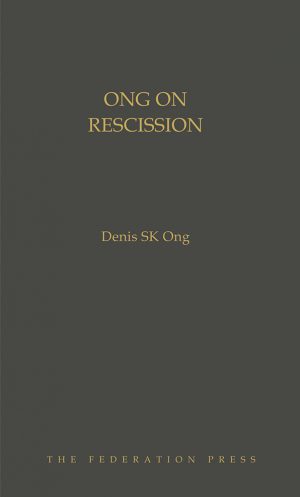Over the past decade, the High Court has repeatedly rejected the notion that there is a unifying principle of unjust enrichment at the plaintiff’s expense, in contrast to the position in the UK. This book provides a vigorous and sustained justification for the Australian position, and demonstrates that the law in the UK has generated more fictions than it was ever thought to abolish. The law of restitution is shown to comprise several fundamentally distinct legal concepts which fill gaps in the law of contract and tort, and which have nothing in common beyond the historical accident that they arose out of the action of indebitatus assumpsit. These are (i) the recovery of non-voluntary payments (by mistake, duress, undue influence, unconscionable dealing and total failure of consideration); (ii) remuneration for goods or services requested by the defendant in circumstances indicating a promise to pay for them; and (iii) the protection of certain facilitative institutions of private law (such as private property and fiduciary relationships). The book staunchly defends the traditional common law approach of analysing legal principles by the empirical method of treating like cases alike, rather than by derivation from supposedly unifying theories. This edition updates the first edition, which was published in 1998, in the light of almost 20 years of case-law and academic debate. It also adds a separate chapter dealing with the history of the law of restitution and why it matters.
Shop
The Varieties of Restitution eBook
2nd edition
| Author | |
|---|---|
| ISBN | 9781760024727 |
| Publication Date | 17/03/2017 |
| Format | eBook |
| Page Extent | 256 |
AUD $150.00 gst included
Preface
Abbreviations
Table of Cases
Table of Statutes
1. Introduction
2. The History of Restitution and Why It Matters
3. Mistaken Payments
4. Duress, Undue Influence and Unconscionable Dealing
5. Payments Made on a Total Failure of Consideration
6. Voluntary Provision of Benefits in Kind
7. Non-Voluntary Provision of Benefits in Kind
8. Restitution for Wrongs
9. Proprietary Claims and Proprietary Remedies
10. Defences
Index
Tom Prince, Bar News, NSW Bar Association, Spring 2017Almost two decades have passed since the publication of the first edition of this fine book. During that time the landscape
of the law of restitution in Australia has substantially changed. The publication of a second edition has been long awaited.
The principal argument of the book
is unchanged. It is that, contrary to
the position adopted in England, the
law of restitution cannot be explained
by reference to the unifying principle
of reversing ‘unjust enrichment at the plaintiff’s expense’. The author then
goes on to argue that there are three ‘varieties’ of restitution involving different conceptions of injustice. …
The book is well written and easy to
read … it is an insightful and intelligent work that is essential reading for those interested in the law of restitution. It is to be hoped that the next edition does not take another two decades.







